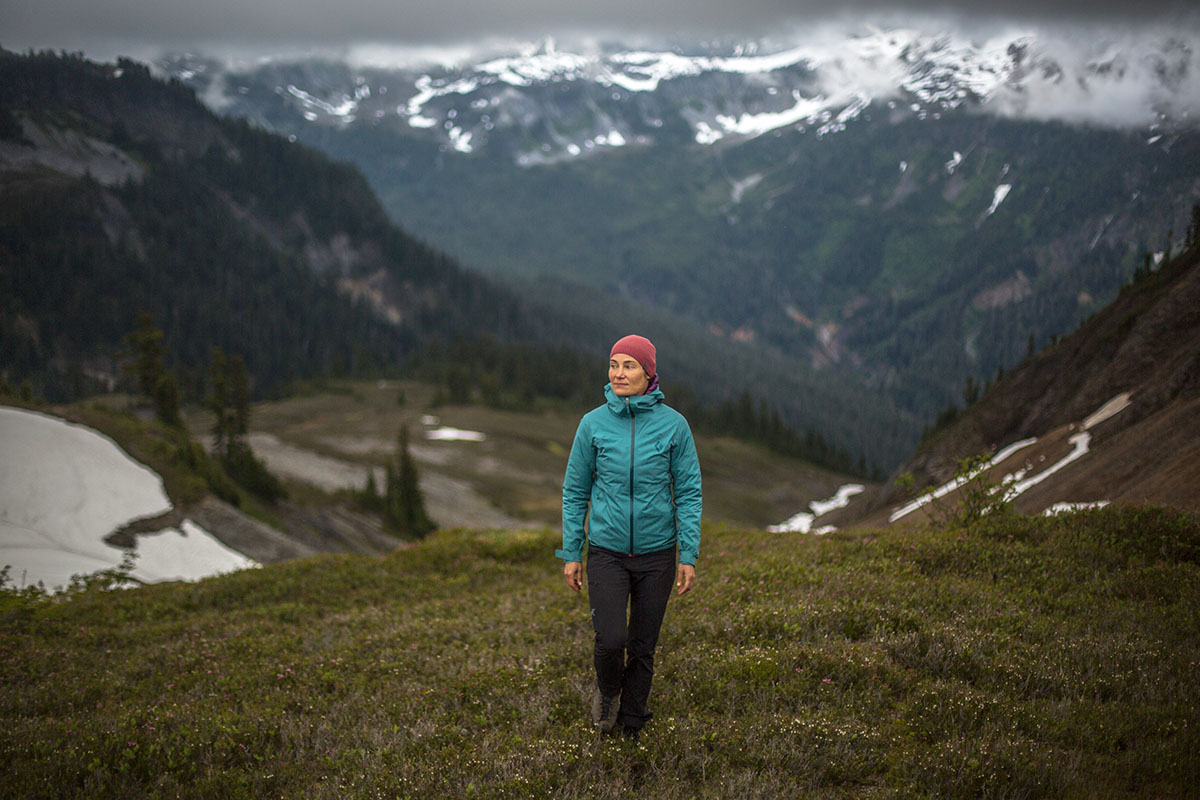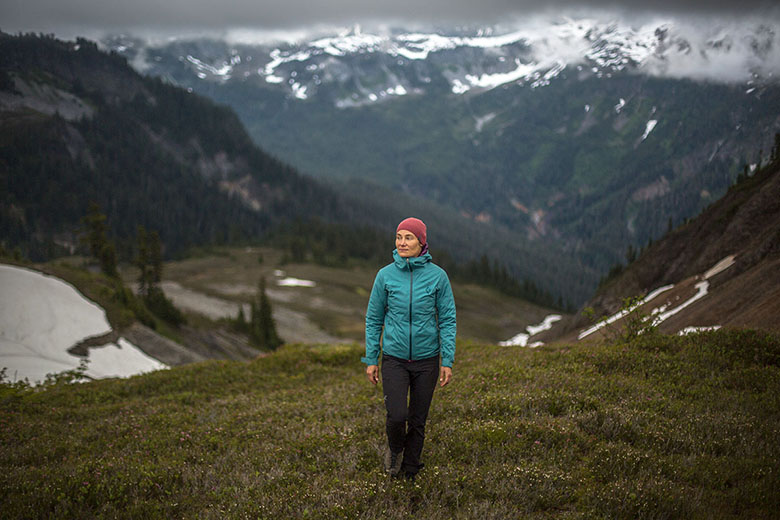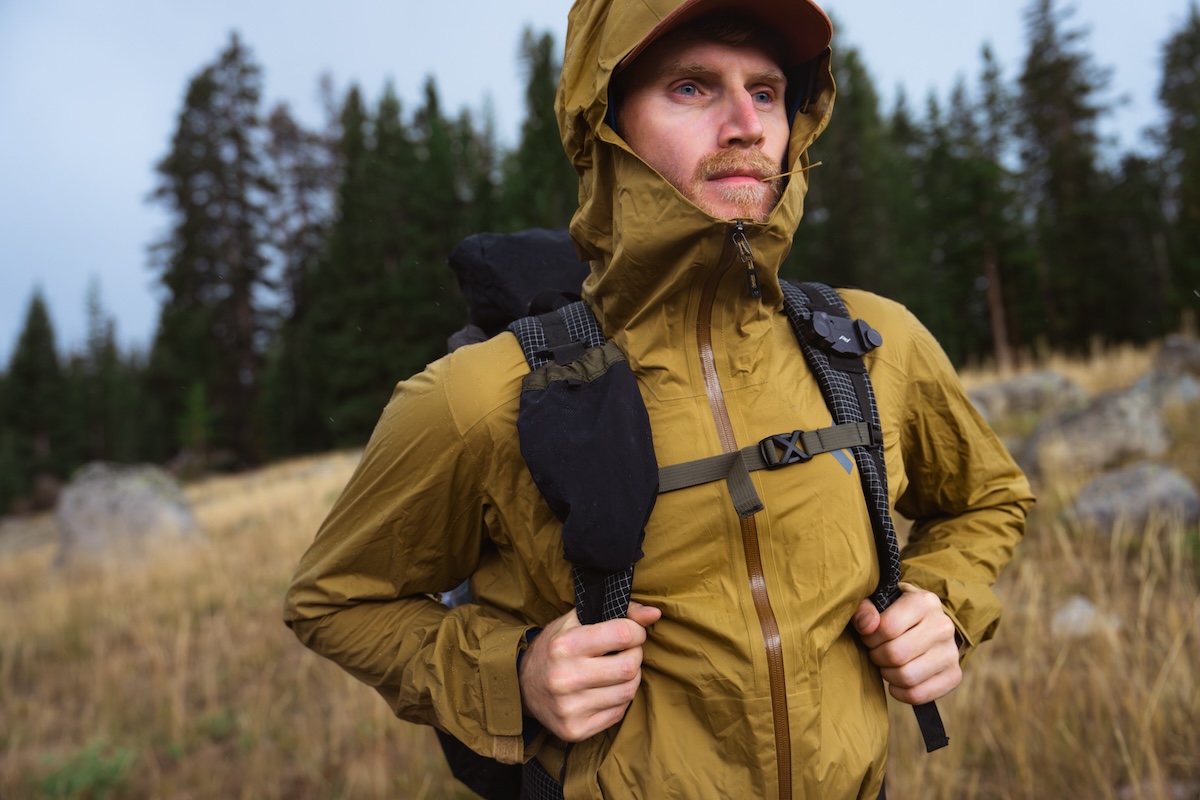

Price: $180
Weight: 9.5 oz. (women's)
Waterproofing: 2.5L BD.dry
What we like: Lightweight for a fully featured rain jacket; stretch adds mobility and comfort.
What we don't: Breathability falls short compared to pricier 3-layer hardshells.
See the Women's Black Diamond Fineline See the Men's Black Diamond Fineline
Black Diamond has assembled a solid lineup of quality rain jackets and hardshells over the last several years, and the Fineline (formerly called the StormLine) is yet another standout. By adding stretch into the jacket’s face fabric, BD created an impressively lightweight, weatherproof, durable, and mobile rain shell that pairs well with activities like hiking, biking, and running. After putting the women's Fineline through extensive use in the wet and unrelenting Pacific Northwest, we came away with high praise. Below we outline the Fineline Stretch's performance. To see how it stacks up to the competition, see our articles on the best rain jackets and best women's rain jackets.
Editor's note: We updated this review on March 3, 2025 to swap all in-text references from the StormLine Stretch to the Fineline Stretch Shell. The two designs are largely identical apart from the name change, so we've opted to retain photos from our testing of the StormLine jacket. We will update the review with fresh Fineline photos as soon as possible.
Featuring Black Diamond’s in-house BD.dry waterproof membrane and backed by a durable water repellent (DWR) finish, the Fineline Stretch Rain Shell is a formidable barrier against rain and wind. Although the jacket has a 2.5-layer construction (as opposed to the 3-layer build typical of pricier hardshells), it’s still impressively weather-worthy. I’ve taken the Fineline as my sole outer layer on numerous backcountry hiking and biking trips in the Pacific Northwest—all of which have included at least one downpour—and it has held up remarkably well while keeping my baselayers dry. Additionally, I’ve experienced no leakage through the zippers. Black Diamond was very thoughtful here: The pit zips are DWR-coated, the front zipper is made with YKK waterproofing, and the hand pocket zippers are covered by generous flaps that prevent water from creeping inside (although these aren’t waterproof).
.jpg)
Another factor that can heavily impact weather protection is fit. With the Fineline, I found the sleeves to be a good length for protecting my arms and wrists, and by toggling the generous Velcro cuff, I was able to protect my baselayers from getting wet. The jacket also has an elastic drawcord at the hem, which can be pulled tight to seal out moisture. When testing another rain shell earlier in the year, my midlayer grew soaked when rain entered at the wrists and hem. This admittedly was my fault and could have been prevented, but it nevertheless made me partial to jackets with generous, adjustable sleeves and hems—and the Fineline fits that bill nicely.
.jpg)
The Black Diamond Fineline Stretch also provides a capable barrier against wind. I wore the jacket while riding my bike over several passes in British Columbia’s Chilcotin mountains—one of which was aptly named “Windy Pass”—and was pleasantly surprised by how skillfully it fended off gusts. In fact, I found it to be a great riding companion for descents where windchill is a constant concern. By the end of the trip, the Fineline had proven itself as a competent and weather-worthy multi-sport jacket.
.jpg)
The Fineline's calling card is its stretchy face fabric, which gives the jacket added elasticity and comfort. The bump in freedom of movement is especially great for mobility-dependent activities like hiking, climbing, biking, and running. Black Diamond certainly isn’t the only brand that offers a stretchy rain shell—Outdoor Research offers the Stratoburst Stretch in addition to their pricier and mountain biking-focused Freewheel MTB Stretch, and REI’s Flash Stretch is another relatively affordable (albeit less performance-ready) design. Still, the Fineline remains our favorite in this category for its great overall execution at a competitive weight and price.
.jpg)
At a listed weight of 9.5 ounces for the women’s model, the Fineline Stretch is one of the lightest fully featured rain jackets on the market. For reference, it’s considerably lighter than REI’s similarly intentioned Flash Stretch (14.5 oz.). It also undercuts leading, non-stretchy designs like the Marmot Minimalist Pertex (11 oz.) and Patagonia Torrentshell 3L (12.4 oz.), although both of those jackets are more everyday-focused and less performance-ready than the Fineline. All things considered, I think Black Diamond did a really nice job balancing weight and features. And when it comes time to stuff it down, the jacket easily stows into its right hand pocket (I also was able to fit it in a bike jersey pocket or small hydration pack), which includes a carabiner-ready loop for clipping to a climbing harness or backpack.
.jpg)
2.5-layer rain shells typically don’t breathe as well as 3-layer hardshell jackets, and we found this to hold true with the Fineline Stretch. While mountain biking and running with the jacket fully zipped, I struggled to effectively cool off. However, I should note that it was an unseasonably warm and humid summer in the Pacific Northwest. Further, it’s somewhat unrealistic to expect both excellent waterproofing and standout breathability—one often is sacrificed—and especially at this price point. On the bright side, the Fineline features generous pit zips, which work well for dumping heat quickly. If I’m quick to open them when exerting energy, the clamminess quickly dissipates and I can regulate temperature more easily. Finally, the lining inside the jacket is textured and doesn’t feel plasticky (a common complaint we have with rain jackets), but it still is a bit sticky on wet skin. This is especially noticeable when I try to slide damp, bare hands into my pockets.
.jpg)
The Fineline Stretch features an adjustable, helmet-compatible hood that just works. It easily fits over all of my climbing and mountain bike helmets, and the stretchy fabric adds comfort and a bit of “give” around the neck. Additionally, the brim is nicely sized and has managed to keep all rain out of my eyes (unless it’s falling at an angle or I’m running/biking into it). Finally, an elastic pull cord at the back of the head allows you to cinch down the hood and secure it in place whether you’re wearing a hat, helmet, or nothing at all underneath.
.jpg)
Black Diamond included the standard two zippered hand pockets on the Fineline Stretch Shell but chose to forego a chest pocket. We can understand this decision—the jacket is competitively light as a result (zippers add a good amount of weight), and there’s still enough space for valuables. As I touched on above, both hand pockets feature a generous flap that protects against moisture, and I’m a big fan of being able to stuff the jacket into its own right hand pocket.
.jpg)
Because of its added elasticity, the Black Diamond Fineline feels significantly more tear-resistant than non-stretchy rain jackets. Unfortunately, BD doesn't list the denier (fabric thickness) of the Fineline, but I've had only positive experiences. More specifically, I’ve worn the shell under numerous backpacking packs and have had no delamination or rubbing-related issues. I do tend to stuff the jacket into its pocket before cramming it into my pack or bike bag to help preserve the outer laminate, but it has nevertheless shown zero signs of wear to date. All seams are intact, the zippers are holding up well, and the jacket looks relatively new after extensive testing. All in all, I’m confident that the Fineline will continue to hardily withstand frequent outdoor use.
.jpg)
I wear a small in most jackets to allow for layering, but an extra small in the Fineline Stretch fit me perfectly. The jacket is by no means bulky, but it is roomy enough to accommodate layers underneath while still being slightly streamlined (BD describes the fit as “regular”). While camping, I often wear several merino baselayers and my Mountain Hardwear Ghost Whisperer down hoody underneath, and even this thick pairing has never felt uncomfortable or restrictive. Further, the longer sleeves are great for biking—when the Velcro is cinched around the cuffs, my baselayers don’t peek out—and the gusseted underarms allow ample mobility. It’s worth noting that my husband tried on the men’s version and found the fit to be notably large and boxy, so I recommend trying on the jacket before buying, if possible.
.jpg)
Like many outdoor brands, Black Diamond has started upping their sustainability focus in recent years. In this case, the Fineline Stretch Shell employs a PFAS-free DWR coating that forgoes per- and polyfluoroalkyl substances—"forever chemicals" that are known for their inability to break down over time. With many states stepping up to ban PFAS, we appreciate that most leading outdoor companies have begun turning to eco-friendlier alternatives. It's worth noting that the prior-generation StormLine Stretch also included bluesign-approved materials, and we wish BD had carried those over to the latest Fineline, but we nevertheless appreciate their ongoing efforts.
.jpg)
For this review, I tested the women’s Fineline Stretch Rain Shell, and Black Diamond makes the same jacket in a men’s version. Compared to the women’s, the men’s Fineline Stretch also retails for $180 and features an identical build with two hand pockets (and no chest pocket), pit zips, an adjustable and helmet-compatible hood, and Black Diamond’s proprietary BD.dry waterproofing. Where the two differ is in weight—the men’s jacket checks in at 11.3 ounces versus the women’s 9.5-ounce weight—and color options. If you live in a notoriously wet climate, Black Diamond also sells Fineline Stretch Full Zip Pants ($155) in both women’s and men's styles, which feature the same waterproofing and stretchy fabric.

.jpg)
| Jacket | Price | Weight | Waterproofing | Denier | Pit Zips | Packable |
|---|---|---|---|---|---|---|
| Black Diamond Fineline Stretch | $180 | 9.5 oz. | 2.5L BD.dry | Unavail. | Yes | Yes |
| Black Diamond Highline Stretch | $400 | 10.7 oz. | 3L BD.dry | 40D | Yes | No |
| Outdoor Research Stratoburst Stretch | $165 | 8.5 oz. | 2.5L Ventia | 50D | Yes | Yes |
| Marmot PreCip Eco Jacket | $120 | 9.0 oz. | 3L NanoPro | Unavail. | Yes | Yes |
| Patagonia Torrentshell 3L Jacket | $179 | 12.4 oz. | 3L H2No | 50D | Yes | Yes |
Stretch-infused rain jackets have grown increasingly common in recent years, providing a nice boost in comfort and mobility compared to traditional designs. For a step up in performance, Black Diamond’s own Highline Stretch Shell is another staff favorite. Comparing the two, the Highline uses a more premium 3-layer construction (also BD.dry) that offers better breathability and protection than the Fineline 2.5-layer build. That said, weight goes up slightly to 10.7 ounces, and the Highline doesn’t pack down into a pocket (or even a separate stuff sack) like the Fineline. For a significant $220 less, the Fineline checks all the boxes for most hikers and everyday wearers, although the hardshell-like Highline is more reliable in true alpine conditions (for more, see our in-depth Highline Stretch review).
Outdoor Research also offers an intriguing competitor to the Fineline in their Stratoburst Stretch Rain Jacket. In terms of advantages, the OR is slightly lighter at 8.5 ounces and $15 cheaper without sacrificing backcountry-ready features like pit zips and a water-resistant main zipper. However, the Stratoburst’s hood isn’t helmet-compatible, and we prefer Black Diamond’s slightly wider and more around town-friendly colorway selection (the two-tone versions of the Stratoburst are fairly techy in appearance). In the end, it’s a close call between the two, but we think the BD is the slightly better-balanced piece. If weight is less of a concern, it’s also worth checking out REI’s Flash Stretch Jacket ($169 and 14.5 oz.).
.jpg)
Transitioning to more traditional, non-stretchy rain shells, Marmot’s PreCip Eco is very popular among hikers, backpackers, and everyday users alike. Recently updated with a more premium 3-layer construction (the prior generation was 2.5L like the Fineline), the PreCip retains performance-ready features like pit zips, a stuff pocket, and adjustability at the hood, hem, and cuffs. It’s also competitively lightweight at just 9 ounces and comes in a wide selection of good-looking colorways. However, the Marmot’s fabric flap covering the main zipper adds a noticeable amount of bulk compared to the BD’s water-resistant design, and breathability suffers as a result of the cheaper build. Overall, the Fineline is the more refined performance piece, but the PreCip Eco is an excellent daily driver for a full $60 less.
.jpg)
Last but certainly not least is a longstanding favorite: Patagonia’s Torrentshell 3L Jacket. As its name suggests, the Torrentshell uses a 3-layer build that offers hardshell-like protection, along with plenty of features for battening down the hatches. You also get a thick shell that holds up well even around sharp gear, great everyday-friendly styling, and thoughtful touches like a microfleece lining at the back of the neck and an adjustable hood that stows away when not in use. The biggest drawbacks are comfort and weight: The Patagonia feels noticeably stiff and crinkly compared to the pliable Fineline, and it’s heavier by around 3 ounces. In the end, for mobility-dependent activities like climbing and biking, we prefer the Fineline Stretch. For hiking and daily wear, the Torrentshell is our top pick.
If you’re thinking about buying gear that we’ve reviewed on Switchback Travel, you can help support us in the process. Just click on any of the seller links above, and if you make a purchase, we receive a small percentage of the transaction. The cost of the product is the same to you but this helps us continue to test and write about outdoor gear. Thanks and we appreciate your support!
Depending on the seller, most products ship free in the United States on orders of $50 or more. International shipping availability and rates vary by seller. The pricing information on this page is updated hourly but we are not responsible for inaccuracies.